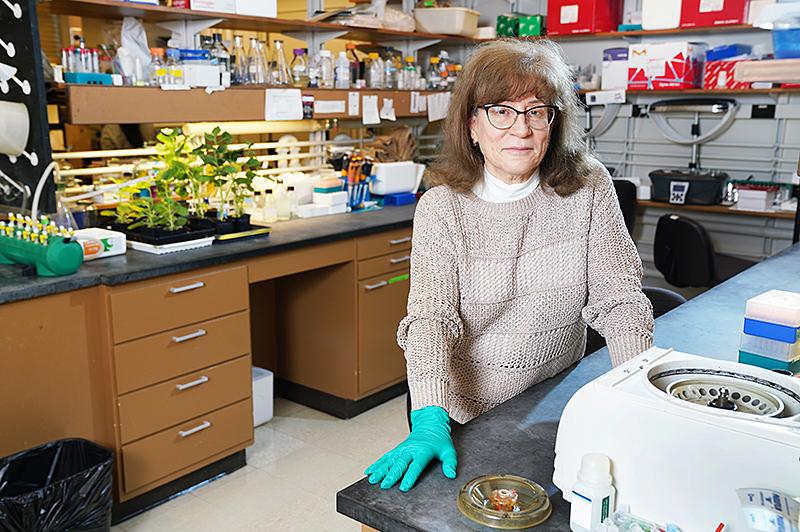博文
植物学家在草药中发现了抗癌化合物的秘诀
 精选
精选
||
植物学家在草药中发现了抗癌化合物的秘诀
诸平





据美国普渡大学(Purdue University)2021年12月20日报道,百里香(Thyme)和牛至叶(oregano)含有一种可以抑制肿瘤发展的抗癌化合物,但在番茄酱中添加更多的百里香和牛至叶并不足以获得显著的益处。解开这些植物力量的关键在于增加化合物的数量,创造或合成此化合物可用于药物开发。普渡大学(Purdue University)的研究人员绘制了这种化合物的生物合成途径(Plant scientists find recipe for anti-cancer compound in herbs),这是将其应用于制药领域的第一步。相关研究结果于2021年12月20日已经在《美国国家科学院院刊》(Proceedings of the National Academy of Sciences简称PNAS)杂志网站发表——Sandra T. Krause, Pan Liao, Christoph Crocoll, Benoît Boachon, Christiane Förster, Franziska Leidecker, Natalie Wiese, Dongyan Zhao, Joshua C. Wood, C. Robin Buell, Jonathan Gershenzon, Natalia Dudareva, Jörg Degenhardt. The biosynthesis of thymol, carvacrol, and thymohydroquinone in Lamiaceae proceeds via cytochrome P450s and a short-chain dehydrogenase. Proceedings of the National Academy of Sciences, December 28, 2021, 118(52): e2110092118. doi.org/10.1073/pnas.2110092118. https://doi.org/10.1073/pnas.2110092118.参与此项研究的除了普渡大学的研究人员之外,还有来自美国密歇根州立大学(Michigan State University)、德国马丁路德大学(Martin Luther University Halle-Wittenberg, 06120 Halle, Germany)、马克斯·普朗克化学生态学研究所(Max Planck Institute for Chemical Ecology, 07745 Jena, Germany)以及法国里昂大学(University of Lyon)的研究人员。
普渡大学农学院(Purdue's College of Agriculture)的生物化学杰出教授、该项目的共同负责人娜塔丽雅·杜达瑞娃(Natalia Dudareva)说:“这些植物(plants)含有重要的化合物,但含量很低,难以提取。通过了解这些化合物是如何形成的,我们开辟了一条道路,让植物具有更高水平的这些化合物,或在微生物中合成这些化合物用于医疗(medical use)。”
“对植物科学(plant science)来说,现在是一个惊人的时代。我们的工具更快、更便宜,而且提供了更多的洞察力。这就像在观察细胞内部;这几乎是难以置信的。”
百里香酚(Thymol)、香芹酚(carvacrol)和百里氢醌(thymohydroquinone)是唇形科(Lamiaceae family)植物百里香(thyme)、牛至(oregano)和其他植物中的香味化合物。它们还具有抗菌、消炎、抗氧化和其他对人体健康有益的特性。普渡大学植物生物学中心(Purdue's Center for Plant Biology)主任娜塔丽雅·杜达瑞娃说,百里氢醌已被证明具有抗癌特性,这一点尤其值得关注。
在与来自德国的马丁·路德大学(Martin Luther University Halle-Wittenberg in Germany)和密歇根州立大学的科学家的合作中,该团队发现了合成百里氢醌的整个生物合成途径,包括它的前体百里酚(thymol)和香芹酚(carvacrol)的形成,以及在此过程中产生的短命中间化合物。
娜塔丽雅·杜达瑞娃说,这一发现改变了之前对这类化合物形成的看法,这类化合物被称为酚类或芳香型单萜(phenolic or aromatic monoterpenes),在其他植物中只有很少的生物合成途径(biosynthetic pathways)被发现。这项研究的详细内容已经在《美国国家科学院院刊》(PNAS)网站上发表。
论文的第一作者之一、娜塔丽雅·杜达瑞娃实验室的博士后研究人员廖潘(Pan Liao音译)说:“这些发现为工程植物和其他生物中的高价值化合物提供了新的目标。许多植物不仅含有药用成分,而且其中的化合物被用作食品添加剂、香水、化妆品和其他产品。”
既然这一途径已经为人所知,植物学家就可以培育出能够产生更多有益化合物的品种,或者可以将其整合到微生物中,如酵母中进行生产。他说,后一种方法包括发酵过程,以获得有价值的化合物(valuable compounds),许多植物基产品也是如此。发酵过程(fermentation process)对食品、饮料、制药和生物燃料生产非常重要,因此普渡大学现在开设了发酵科学专业(fermentation science major)。
通过RNA测序和相关分析,该团队从植物组织样本中筛选了超过80000个基因,并确定了生产百里氢醌所需的基因。基于已知的化合物结构,并通过代谢物分析和生化测试,该团队确定了生物合成途径。
廖潘说:“在这一途径中形成的中间体并不是我们预测的那样。我们发现,百里香酚和香芹酚的芳香主干都是由γ-松油烯(γ-terpinene)由P450单加氧酶(P450 monooxygenase)和脱氢酶(dehydrogenase)通过两种不稳定的中间体结合形成的,但不是如所提出的对伞花烃(p-cymene)。”
娜塔丽雅·杜达瑞娃说,由于能够使用RNA测序进行高通量基因表达分析,现在正在发现更多的途径。她说,这项研究的结果也将有助于其他植物物种的生物化学和植物科学研究。“我们,作为科学家,总是在比较不同系统和植物的路径。我们总是在追求新的可能性。我们了解的越多,就越能认识到相似和不同之处,这可能就是下一个突破的关键。”
上述介绍,仅供参考。欲了解更多信息,敬请注意浏览原文或者相关报道。
Scientists nail down important plant compound pathway
The monoterpene alcohols thymol, carvacrol, and thymohydroquinone are characteristic flavor compounds of thyme, oregano, and other Lamiaceae. These specialized metabolites are also valuable for their antibacterial, anti-spasmolytic, and antitumor activities. We elucidated the complete biosynthetic pathway of these compounds, which starts with the formation of γ-terpinene from geranyl diphosphate. The aromatic backbone of thymol and carvacrol is formed by P450 monooxygenases in combination with a dehydrogenase via an unstable intermediate. Additional P450s hydroxylate thymol and carvacrol to form thymohydroquinone. Our findings demonstrate a mechanism for the formation of phenolic monoterpenes that differs from previous predictions and provides targets for metabolic engineering of high-value terpenes in plants.
Thymol and carvacrol are phenolic monoterpenes found in thyme, oregano, and several other species of the Lamiaceae. Long valued for their smell and taste, these substances also have antibacterial and anti-spasmolytic properties. They are also suggested to be precursors of thymohydroquinone and thymoquinone, monoterpenes with anti-inflammatory, antioxidant, and antitumor activities. Thymol and carvacrol biosynthesis has been proposed to proceed by the cyclization of geranyl diphosphate to γ-terpinene, followed by a series of oxidations via p-cymene. Here, we show that γ-terpinene is oxidized by cytochrome P450 monooxygenases (P450s) of the CYP71D subfamily to produce unstable cyclohexadienol intermediates, which are then dehydrogenated by a short-chain dehydrogenase/reductase (SDR) to the corresponding ketones. The subsequent formation of the aromatic compounds occurs via keto–enol tautomerisms. Combining these enzymes with γ-terpinene in in vitro assays or in vivo in Nicotiana benthamiana yielded thymol and carvacrol as products. In the absence of the SDRs, only p-cymene was formed by rearrangement of the cyclohexadienol intermediates. The nature of these unstable intermediates was inferred from reactions with the γ-terpinene isomer limonene and by analogy to reactions catalyzed by related enzymes. We also identified and characterized two P450s of the CYP76S and CYP736A subfamilies that catalyze the hydroxylation of thymol and carvacrol to thymohydroquinone when heterologously expressed in yeast and N. benthamiana. Our findings alter previous views of thymol and carvacrol formation, identify the enzymes involved in the biosynthesis of these phenolic monoterpenes and thymohydroquinone in the Lamiaceae, and provide targets for metabolic engineering of high-value terpenes in plants.
https://blog.sciencenet.cn/blog-212210-1317732.html
上一篇:3D打印纳米磁铁揭开了磁场中图案的世界
下一篇:海啸磁场在海平面变化之前可被探测到?